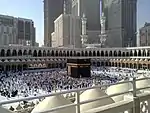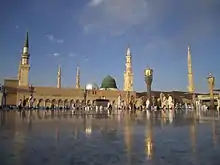Great Mosque of Kufa
The Great Mosque of Kufa (Arabic: مَسْجِد ٱلْكُوفَة ٱلْمُعَظَّم/ٱلْأَعْظَم, romanized: Masjid al-Muʿaẓẓam/al-ʾAʿaẓam), or Masjid al-Kufa, is located in Kufa, Iraq and is one of the earliest and holiest surviving mosques in the world. The mosque, built in the 7th century, was home to Ali ibn Abi Talib, the 4th Rashidun caliph; and contains the remains of Maytham al-Tammar,[2] Ali's companion; Muslim ibn Aqeel, first cousin of Husayn ibn Ali, his companion Hani ibn Urwa; and the revolutionary, Al-Mukhtar.[3] In recent history, the mosque has seen numerous renovations primarily under the purview of the Dawoodi Bohras,[1]:82,97,106[4] led by Mufaddal Saifuddin.
| Mosque of Kufa | |
|---|---|
| |
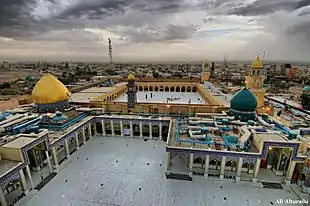 The mosque of Kufa | |
| Religion | |
| Affiliation | Islam |
| Rite | Shia |
| Ecclesiastical or organizational status | Mosque and Shrine |
| Status | Active |
| Location | |
| Location | Kufa, Iraq |
| Municipality | Najaf Governorate |
| Country | Iraq |
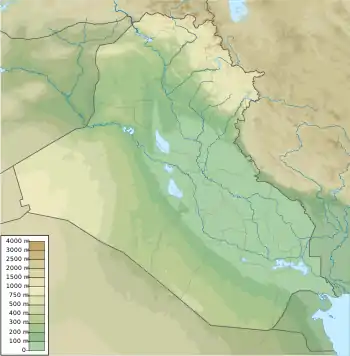 Location in Iraq | |
| Geographic coordinates | 32°01′43″N 44°24′03″E |
| Architecture | |
| Type | Islamic, Fatimid |
| Founder | Ali ibn Abi Talib |
| Funded by | Dawoodi Bohras[1]:106 |
| Completed | 670 CE |
| Specifications | |
| Interior area | 11,000 square metres (120,000 sq ft) |
| Dome(s) | 1 |
| Minaret(s) | 4 |
| Shrine(s) | 3 |
| Website | |
| www | |
Origin
Sources attribute the construction of the Great Mosque of Kufa in the middle of the 7th century to the Caliph Omar.[5] There is a legend that says the edifice was built on a temple constructed by Adam while another claims that Adam's bones were buried on the site, having been carried by Noah on board the Ark.[5] It is also believed that the angel Gabriel was referring to the mosque when he declared, "Twelve miles of lands from all directions of the mosque are blessed by its holiness." The site was identified in Shia Islam as the place where Noah must build his Ark. The family members of the first Shiite imams and their early supporters were buried within.[6]
Architectural excavations revealed that the mosque, which dates from 670, was built on top of much older foundations.[6]
Architecture
The area of the building measures approximately 11,000 square metres (120,000 sq ft).[7] The mosque contains nine sanctuaries and four traditional locations. As to its design, experts recognized similarities to the design of the palaces of pre-Islamic Persia.[6] It has four minarets and is accessible through five gates:[7][8] Gate of the Threshold (Bāb al-Sudda), Gate of Kinda (Bāb Kinda), Gate of al-Anmat (Bāb al-Anmāṭ), Gate of the Snake (Arabic: باب الثعبان, romanized: Bāb al-Thu‘bān).,[9][10] and Gate of Hani ibn Urwa.
Renovation
The Great Mosque of Kufa has previously underwent sporadic renovations. One historical account, for instance, noted enlargement of section as well as a raised flooring for the main building in comparison to earlier level.[11] In 1998, head of Dawoodi Bohra community, Mohammed Burhanuddin started renovating the mosque,[12] which was then completed in early 2010. The renovation included decorations with gold and silver, the Mihrab being made with a gold zari, and the whole interior being surrounded with verse of the Quran. In addition, the courtyard is covered in white marble from Makrana, India.[12]
Significance
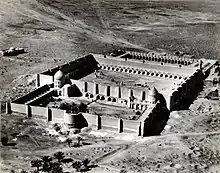
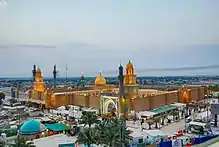

- It was the place where Ali ibn Abi Talib was fatally wounded by a poison-coated sword while prostrating in the Fajr prayer.[13]
- Contains the tombs of Muslim ibn Aqeel, Hani ibn Urwa, and Al-Mukhtar
- There are markers within the mosque indicating the locations for where the court of Ali used to preside, where he performed miracles, and where Zayn al-Abidin and Ja'far al-Sadiq used to perform Salah
- Islamic traditions relate that it was the dwelling place of Nuh (Noah) and that this was the place where he built the Ark[14]
- According to Shia belief, it was from this mosque that the diluvium of Noah started submerging earth, as well as being the place from where the water was re-absorbed [15] - also marked within the Mosque
- Ja'far al-Sadiq said that up to twelve miles of land in all directions from the mosque are blessed by its holiness.[14]
- Ja'far al-Sadiq was also recorded as remarking that the "mosque in Kufa is superior to that of Jerusalem"[16] and that "performing two prostrations of prayer here would be better for me than ten others at any mosque."[14]
- There are also Shia traditions which state that performing one prayer in this mosque is the same as having performed one thousand prayers elsewhere,[17] and performing one obligatory prayer here is equal to having performed an accepted Hajj
[18] - The secretariat of Al-Kufa Mosque and its shrines describes the mosque as being one of the sole four dignified mosques to which Muslims must travel, and that it comes in third place after the Kaaba and the mosque of Prophet."[19]
- According to Shia belief, it is from this mosque that the messianic twelfth Imam, Hujjat-Allah al-Mahdi, will rule the world from, and it will serve as the seat of his power in the end of times.
See also
References
- Mervin, Sabrina; Tabbaa, Yasser; Bonnier, Erick (2014). Najaf, The Gate of Wisdom. History, Heritage and Significance of the Holy City of the Shi‘a. World Heritage. Unesco Publication Center. ISBN 9789231000287. Archived from the original on 7 June 2019. Retrieved 1 Jun 2020 – via halshs.com.
- "The Great Mosque of Kufa in Photos". iqna.ir. Archived from the original on 11 May 2020. Retrieved 11 May 2020.
- "Hundreds of thousands' Friday assemblage in Masjid-e-Uzma Kufa". Jafariyanews.com. Archived from the original on 2 August 2016. Retrieved 20 November 2008.
- "A Century of Hope Beings New Promise". timesofindia.com. 13 March 2012. Archived from the original on 11 May 2020.
- Costa, Nicholas (2013). Adam to Apophis: Asteroids, Millenarianism and Climate Change. D'Aleman Publishing. p. 194. ISBN 9789963291700.
- Marshall Cavendish Reference (2011). Illustrated Dictionary of the Muslim World. Marshall Cavendish. pp. 152. ISBN 9780761479291.
- "General Facts and Numbers". The Official Website of Secretariat of Al-Kufa Mosque and it Shrines. Archived from the original on 2010-07-31. Retrieved 2009-03-01.
- Sindawi, Khalid (2008). "Mītham b. Yaḥyā al-Tammār: an important figure in early Shī'ism". Al-Qanṭara. 29 (2): 269–291. ISSN 0211-3589. Archived from the original on 2012-07-01. Retrieved 2017-09-20.
- "بابالثعبان هذا الاسم الذي حاول بنو أمية ومن تلاهم تغييره ولم يستطيعوا و بقي رمزا لمسجد الكوفة ومنقبة من مناقب الإمام علي (عليه السلام)" [Bab al-Tha'ban, this name which the people of Umayyah and those who followed tried to change and could not and remained a symbol of the Kufa Mosque and excavated from the venerable Imam Ali (peace be upon him).] (in Arabic). Official website of Great Mosque of Kufa. Archived from the original on 19 September 2013. Retrieved 18 June 2016.
- "تو دستگير شو اي خضر پي خجسته". ISNA Fars. Archived from the original on 17 May 2016. Retrieved 18 June 2016.
- Bosworth, Clifford (2007). Historic Cities of the Islamic World. Leiden: BRILL. p. 295. ISBN 9789004153882.
- Kartikeya (21 March 2010). "Bohras help War-ravaged Kufa get back its glory". Times of India. Archived from the original on 29 October 2017. Retrieved 15 September 2017.
- Tabatabaei, Sayyid Mohammad Hosayn (1979). Shi'ite Islam. Suny Press. p. 192. ISBN 978-0-87395-272-9.
- "The Establishment of the Mosque". The Official Website of Secretariat of Al-Kufa Mosque and it Shrines. Archived from the original on 2010-07-31. Retrieved 2009-03-01.
- al-Qummi, Ja'far ibn Qūlawayh (2008). Kāmil al-Ziyārāt. trans. Sayyid Mohsen al-Husaini al-Mīlāni. Shiabooks.ca Press. pp. 66–67.
- Gold, Dore (2007). The Fight for Jerusalem. Regnery. p. 91. ISBN 978-1-59698-029-7.
the fight for jerusalem.
- al-Qummi, Ja'far ibn Qūlawayh (2008). "8". Kāmil al-Ziyārāt. trans. Sayyid Mohsen al-Husaini al-Mīlāni. Shiabooks.ca Press. p. 47.
- al-Qummi, Ja'far ibn Qūlawayh (2008). "8". Kāmil al-Ziyārāt. trans. Sayyid Mohsen al-Husaini al-Mīlāni. Shiabooks.ca Press. p. 44.
- "The Establishment of the Mosque". The Official Website of Secretariat of Al-Kufa Mosque and it Shrines. Archived from the original on 2010-07-31. Retrieved 2009-03-01.
It is the one the sole four dignified mosques, to which Muslims must travel, and it comes in the third place after the Mosque the Kaaba, the mosque of Prophet
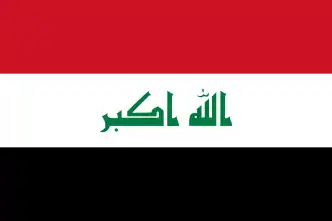
.jpg.webp)
